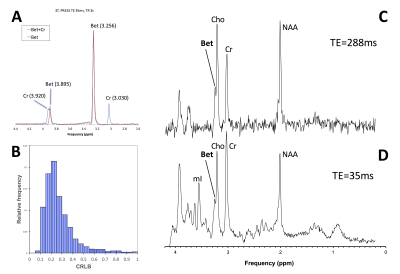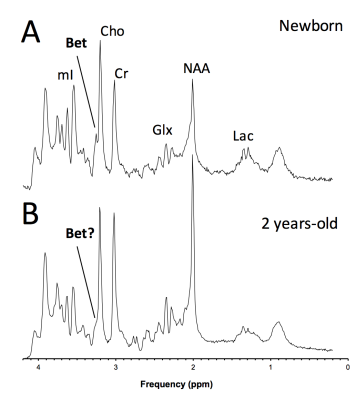4029
Betaine detection in human brain1USC/Children's Hospital Los Angeles, Los Angeles, CA, United States, 2Rudi Schulte Research Institute, Santa Barbara, CA, United States
Synopsis
Betaine, an essential osmolyte and source of methyl groups, is a metabolite known to be present in brain. However, due to its low concentrations and its overlap with the choline signal, betaine detection and quantitation is difficulty. In this study, we quantified betaine in high-quality spectra of pediatric patients and controls. The measured betaine concentrations of 0.1 - 0.2 mM are consistent with what has been measured in rat brain extracts by high-field NMR.
Introduction
Betaine (Bet), an essential osmolyte and source of methyl groups, is known to be present in brain1,2. However, in vivo Bet concentrations are low and the main Bet signal overlaps/is immediate adjacent to the more prominent signal form choline-containing metabolites (Cho). Thus, Bet detection and quantification has been difficult. We have acquired a large number of spectra from pediatric patients, particularly newborns, on clinical 3T scanners, with improved spectral resolution, when compared with 1.5T studies. Our goal was to determine whether betaine signal is consistently detectable and to provide estimates of the in vivo betaine concentrations of the human brain.Methods
MR spectra acquired from a total of 1829 patients and controls on clinical 3T scanners (Philips Achieva and Ingenia) with single-voxel PRESS TE=35ms, TR=2sec) over a period of eight years (2008-2016) were systematically evaluated. All spectra were processed with fully automated LCModel software (version 6.3-1L). Spectra of model solutions of Bet and of Bet + creatine (Cr) were acquired and a simulated betaine basis spectrum with peaks at 3.26 and 3.90 ppm was added to the default basis set. 3574 parietal white matter (WM), parieto/occipital grey matter (GM), thalamus (THAL), and basal ganglia (BG) spectra acquired from 1351 patients (0 < age < 58 years) passed quality criteria of full width at half maximum (FWHM) of < 0.04 ppm and signal-to-noise ratio (SNR) > 10 (FWHM and SNR as reported by LCmodel). Absolute Bet concentrations were estimated by using the unsuppressed water signal as internal reference assuming a water content of 75% (41.7Mol/l). In addition, 14 PRESS long TE (288ms) spectra from 10 patients were reviewed.Results
MR spectra of model solutions of Bet and Bet + creatine (Cr) show Bet peaks at ≈ 3.26 and 3.90 ppm (Fig. 1A). 75% of spectra had Cramer-Rao Lower Bounds (CRLB) of less than 30% (Fig. 1B) and there was no significant positive or negative cross-correlation with taurine, myo-inositol or any other metabolite contributing signal to this area of spectra. Signal consistent with Bet was observed in both long TE and short TE spectra (Fig. 1C,D). Among patients with “unremarkable” MRI report, Bet concentrations in the younger cohort (< 18 months post-conceptual age (PCA)) were ≈ 0.3 mM, which was significantly higher (p<0.001) than levels of ≈ 0.1 mM in children > 18 months PCA (Fig. 2, Tab. 1). The estimated Bet concentrations are consistent with concentrations measured from rat brain extracts by high-resolution NMR3. Among patients with abnormal MRI, it was noted that Bet appears to be present at higher levels in acute and severe infarcts (Fig. 3).Discussion and Conclusions
Betaine is an important osmolyte and abnormal betaine has been associated with metabolic syndrome, diabetes and other disorders. In addition, it has been postulated that betaine is important in early development4-6. In tissue, betaine is synthesized from choline. Detection and quantitation of betaine is of potential clinical significance. On the other hand, quantitation by in vivo MRS has been challenging due to proximity of its main peak at ≈ 3.26 ppm to prominent signal from choline-containing metabolites. However, advances in technology, i.e. the improved spectral resolution at 3T, allow its detection in a clinical setting.Acknowledgements
Rudi Schulte Research InstituteReferences
1. Kempson SA, Zhou Y, Danbolt NC. The betaine/GABA transporter and betaine: roles in brain, kidney, and liver. Front Physiol. 2014; 5:159.
2. O'Leary-Moore SK, Galloway MP, McMechan AP, Hannigan JH, Bowen SE. Region-dependent alterations in glutamate and GABA measured by high-resolution magnetic resonance spectroscopy following acute binge inhalation of toluene in juvenile rats. Neurotoxicol Teratol. 2007; 29(4):466-475.
3. Lien YH, Shapiro JI, Chan L. Effects of hypernatremia on organic brain osmoles. J Clin Invest. 1990; 85(5):1427-1435.
4. Lever M, Slow S. The clinical significance of betaine, an osmolyte with a key role in methyl group metabolism. Clin Biochem. 2010; 43(9):732-744.
5. Wu BT, Dyer RA, King DJ, Richardson KJ, Innis SM. Early second trimester maternal plasma choline and betaine are related to measures of early cognitive development in term infants. PLoS One. 2012; 7(8):e43448.
6. Ueland PM, Holm PI, Hustad S. Betaine: a key modulator of one-carbon metabolism and homocysteine status. Clin Chem Lab Med. 2005; 43(10):1069-1075.
Figures



